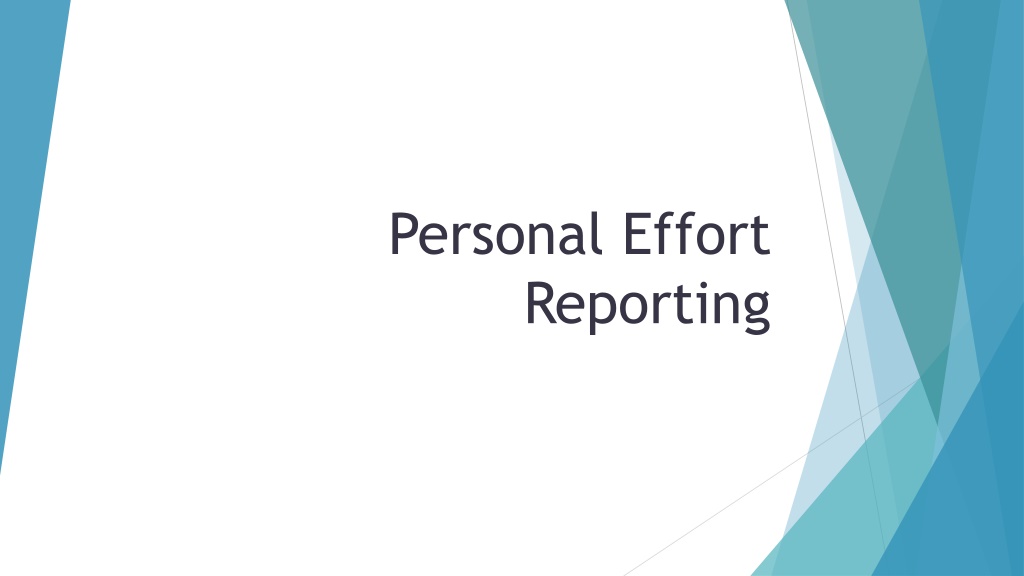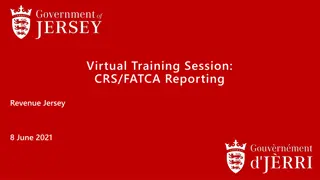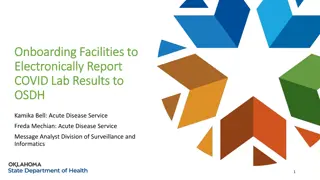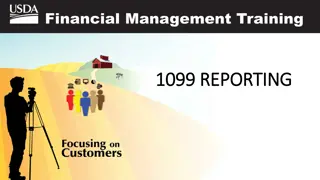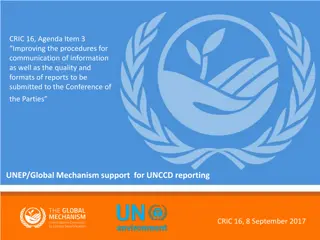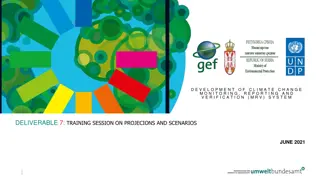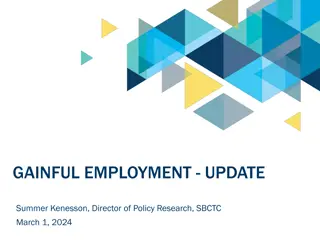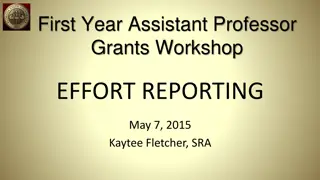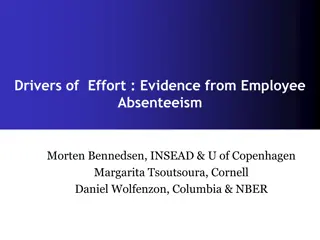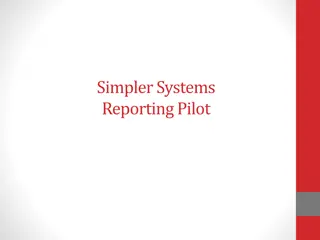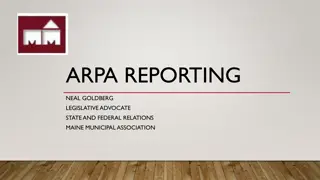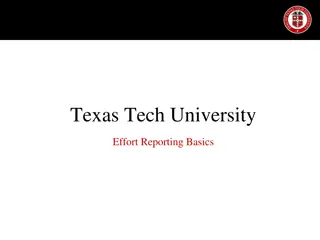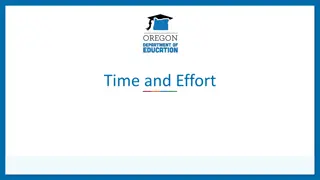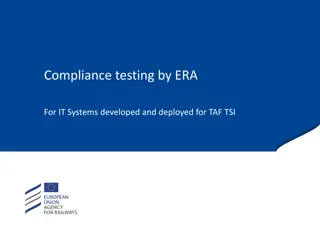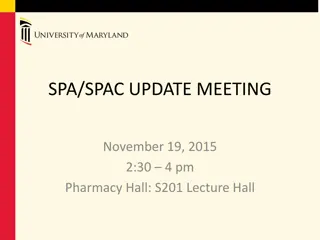Effort Reporting for University Compliance
Effort reporting, through ePERs, is crucial for complying with federal regulations in academic institutions like universities. Employees must certify their effort accurately and timely to avoid penalties and ensure project funding alignment. Learn about ePER release dates, access points, certification rules, and more.
Download Presentation

Please find below an Image/Link to download the presentation.
The content on the website is provided AS IS for your information and personal use only. It may not be sold, licensed, or shared on other websites without obtaining consent from the author.If you encounter any issues during the download, it is possible that the publisher has removed the file from their server.
You are allowed to download the files provided on this website for personal or commercial use, subject to the condition that they are used lawfully. All files are the property of their respective owners.
The content on the website is provided AS IS for your information and personal use only. It may not be sold, licensed, or shared on other websites without obtaining consent from the author.
E N D
Presentation Transcript
Personal Effort Reporting
What is Effort Reporting? An ePER is an electronic Personnel Effort Report. The University uses ePERs to comply with federal regulations commonly known as Uniform Guidance. Every employee who is paid from or has committed cost sharing effort to a federally sponsored project is required to certify an ePER. Certification confirms to the sponsor that the effort being put into a project matches the effort being paid by grant funding. It is the employee and their supervisor s responsibility to certify their efforts in a timely manner. When you do not certify the ePER accurately or on time it puts the University at risk for potential penalties from the sponsoring agency.
When do employees receive their ePERs? The ePERs are released at the end of every semester. The employee will receive an email the day that they are released. The ePERs are based off the below time range. Date Range January 1st May 31st June 1st August 31st September 1st December 31st Semester Spring Semester Summer Semester Fall Semester
Where can I access Effort Reports as an employee or supervisor? Log into your campus portal. Click on the CU Resources Home drop-down menu. Select Business Tools. Click on the ePERs tile.
Who has access to ePERs? Access to the ePERs tile is automatically generated for these scenarios: The person is an employee paid by a sponsored project and has been issued their first ePER The person is a supervisor of an employee that receives an ePER The person is a PI listed on a sponsored project on an ePER The person is an OGC administrator
Five Rules to Remember 1. Every employee paid by a federally sponsored project must certify their effort. 2. The ePER must be certified in a timely manner every semester. 3. Total effort for all positions (sponsored and non-sponsored) combined must equal 100%. Project effort is measured by the percentage of your total work, and the ePERs cannot be certified unless the total effort equals 100%. 4. Effort reports are generated based on the posted salary entered into PeopleSoft; they should be certified base on the actual work expended on the project. If these amounts differ, the employee needs to contact their payroll liaison or supervisor. 5. Effort that involved committed cost sharing must be reported.
What do the ePER statuses mean? There are four different outstanding statuses on an ePER report. N Not Certified P - PET required (Pending Payroll Adjustment) R - Revised PER Issued (Revised) H - Hold (On Hold)
What do the ePER statuses mean? Cont. P - PET required (Pending Payroll Adjustment) The employee has tried certifying less than the pay with cost share. If the employee believes their actual effort percentage is less than what their pay with cost share percentage is, the employee will need to work with the payroll liaison to create a PET to move pay off that sponsored project. If the effort is correct, the employee needs to certify the actual effort percentage for greater than or equal to the pay with cost share.
What do the ePER statuses mean? Cont. R - Revised PER Issued (Revised) Something in the system (typically a PET) was submitted that caused the ePER to change. The employee will need to recertify for the updated effort. If they have issues with the percentages, they need to work with their payroll liaison.
What do the ePER statuses mean? Cont. H - Hold (On Hold) Payroll suspense Payroll error negative pay Off cycle issue Dock with funding change Retroactive job changes Effort with Cost Share exceeds 100% Reach out to epers@ucdenver.edu for questions and information related to potential payroll errors.
What is the timeframe to certify ePERs? The timely manner to complete the ePER is 30 days from the day the ePER was generated, but policy indicates it must be certified within 120 days. Reminders to certify are sent to the employee s email every 30 days. Please note that ePERs with a hold status will not receive emails until the hold is cleared. If the employee has not certified their ePER by 120 days, they will get a reminder email every 10 days. The supervisor during the time of the ePER and the current supervisor will be cc d in the reminder email until the ePER is certified.
Who can certify ePER reports? If the employee s employment status is active The employee or the direct supervisor can certify the ePER in the system. If the employee s employment status is terminated The direct supervisor can certify the ePER in the system.
Who can certify ePER reports? Cont. If the employee and the employee s supervisor employment status is terminated Please reach out to epers@ucdenver.edu for next steps. OGC will provide guidance on options to certify the ePER. The ePER will need to be certified via a PDF copy of the ePER. The PDF copy is required to have the following: Statement of knowledge of the effort The actual effort % filled out A signature The PDF should be returned to OGC and OGC will certify the ePER in the system.
How are ePERs collected? The reminder emails sent to the employees. The reminder emails sent to the employee and supervisor(s) after 120 days. The uncertified report sent to the org fiscal manager at the beginning of each month. The department s own collection process for ePERs. Direct contact from OGC administrators.
Monthly Uncertified Report This report is released at the beginning of every month. It is sent to the person listed as the fiscal manager on the employee s org. The employee s org is based off the job org listed in HCM. It may be necessary to forward this email to someone else in the department. The report will show you all the people with uncertified ePERs listed in the org. We cannot retroactively change HCM data for employees (org, supervisor, ID, name, etc).
What reports are available to departments to use? There are multiple reports that can be found in CU-Data that departments can use to monitor the uncertified ePERs. The reports are located in the Team content folder, under ePERs tab. The ePERs by Award report will be coming soon.
Close Out and ePERs The best report to use to during close out is All ePERs by Project . Any ePER with a hold status needs to be cleared in order to close a project. It is highly recommended to have all ePERs completed to avoid the risk of needing to reopen the project.
Resources ePERs Skillsoft Training https://universityofcolorado.skillport.com/skillportfe/main.action?path=summary /CUSTOMER_DEFINED/_scorm12_cu_u00055_0001 ePERs Training Webpage https://www.cu.edu/controller/epers-training OGC ePERs Webpage https://research.cuanschutz.edu/ogc/home/ogc-teams/post-award/time-and- effort-reporting ePERs Email Contact epers@ucdenver.edu
